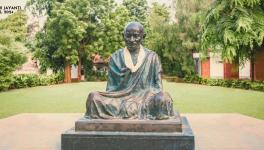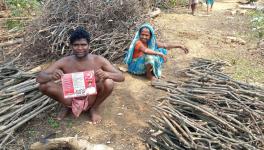COVID-19 in Rural India-XXVIII: Farmers in Gujarat’s Isar Use Crop as Animal Fodder and to Make Manure
Representational Image.
This is the 28th report in a series that provides glimpses into the impact of COVID-19-related policies on life in rural India. The series, commissioned by the Society for Social and Economic Research, comprises reports by various scholars who have been conducting village studies in different parts of India. The reports have been prepared on the basis of telephonic interviews with key informants in their study villages. This article talks about how the lockdown has affected the lives of people in Isar village of Gujarat, where smaller farmers have abandoned their Rabi crop and have already begun cultivating their land.
The village of Isarlies in the Mandavi block of Surat district. It is a gram panchayat spread over 445 hectares, of which nearly 65% is the net cultivated area. Close to 82% of that area is irrigated by an earthen dam and the availability of water has encouraged farmers, the majority of whom are small and marginal ones, to cultivate vegetables during the Rabi season.
The major crops cultivated in the village are rice, mung bean, and vegetables such as okra, guar, chauli (black-eyed pea) and spinach. Of its total population of 1891 individuals, 25% are cultivators while 65% are agricultural labourers, according to the 2011Census.
Lack of access
Conversations with farmers revealed that the lockdown due to COVID-19 has caused a lot of disruption in the village.
Interviews with three farmers—Satishbhai, Vijaybhai, and Bhaljibhai—show that COVID-19 has resulted in several disruptions in the village. All three are marginal farmers who own 2.5, 1.5 and two acres respectively.
Bhaljibhai, a farmer who owns two acres of land, has been the head of the participatory irrigation committee of Isar Dam, for fifteen years. Isar, and other nearby villages, are a cluster for vegetable cultivation, especially okra and guar. The farmers have been facing difficulties in purchasing inputs such as seeds, pesticides, and fertilisers. Satishbhai, another small farmer, said that “the farmers have seen the best yield this year as the rains were plenty. But we did not expect such a shock. This year, most of the farmers have cultivated vegetables,” he added.
We also interviewed Mr Vinit Kumar, representative of the Forest Department.
The farmers are faced with many challenges due to the lockdown. Firstly, the supply of urea has been disrupted. There is a limited stock of urea and other fertilisers. Satishbhai said that a vehicle to supply urea had come by early onemorning last week and the price some farmers paid was Rs 280 per bag, but the fertiliser stock was very soon exhausted. He added that urea was available in a nearby town called Jankhwa, about seven kilometres from their village and that a private shop there was selling the fertiliser for Rs 380 per bag.
Vijaybhai, another small farmer, said that some agriculture input shops wereselling loose urea at a price of almost Rs 400 per bag. On being asked about the situation of other inputs, he suggested that there had not been much disruption to the supply of other inputs as agro-shops remain open until noon. He had already anticipated some of the problems a lockdown would bring and had bought seeds in advance.
However, Bhaljibhai said that the supply of inputs like pesticides had not been regular, and that farmers were buying whatever stock was available at the agro centres even though what was necessary was often unavailable. Adding to their woes, police constables were not allowing easy access to the market. One of the Forest Department clusters in a village called Visdaliya is also supplying inputs such as pesticides, seeds, and fertilisers to some farmers nearby, but it is not enough.
The price of labour had not changed much, but there had been a drop in availability. Bhaljibhai said that most farmers were resorting to using family members for harvesting vegetables, as it was not profitable to engage labour given the market price. The fear of contracting an infection was also a deterrent. Only a few farmers had been engaging labour to harvest vegetables, and even they had stopped.
The labour rate is Rs 130 for harvesting guar between 8 a.m. to 1 p.m. The mobility of labour was at a standstill due to the lockdown; labourers were facing a loss of wages with farmers reluctant to hire both outsiders as well as locals. The demand for labour had also reduced due to the farmers’ inability to take their produce to markets. There was also a cash crunch due to banks being apprehensive about disbursing money—according to Bhaljibhai, bank officials are not giving cash to the farmers even if they have it in their accounts.
Bottlenecks in marketing
Bhaljibhai and Vijaybhai said that a few large farmers have ploughed their lands after feeding surplus vegetables to their cattle. Bhaljibhai added that milk procurement had been consistent and smooth. Farmers from the village are supplying close to 1000 litres of milk everyday to the co-operative, Sumul. “They maintain physical distancing while collecting milk at the cooperative,” he mentioned.
However, the marketing of vegetables has been an issue. The two farmers earlier used to sell their produce to a trader from their village who in turn would sell the produce in cities like Surat and Ahmedabad. Isar village also acts as a crucial collection point for vegetables from tribal villages nearby. But the lockdown had restricted the movements of the village’s farmers. A trader used to employ a driver from the village to transport vegetables to Kalupur mandi in Ahmedabad. After the driver caught a cold, there was panic among the farmers, and the driver was quarantined by the panchayat for fourteen days. He tested negative for COVID-19, but the panchayat decided to ban people from travelling outside the village and people from entering the village, anyway. This restriction has disrupted the collection, weighing and sale of vegetables.
According to Bhaljibhai, the farmers brought up the issue with the panchayat, and have since been allowed to take their vegetables to a new collection centre that has been set up outside the village in the nearby forest, where they must maintain social distancing. However, the trader was offering poor prices: Rs10 per kg for okra and between Rs 10 to Rs 12 per kg for guar— before the lockdown the prices for the two vegetables were Rs 25 and Rs 45 per kg respectively, according to Satishbhai. Some of the traders were also exploiting the situation, he said, mentioning that they were able to sell okra for Rs 30 per kg (Rs 600 per twenty kg) and guar at Rs 45 per kg (Rs. 900 per twenty kg) in Vyara, a town about 28 kms away from Isar.
While farmers can sell okra at the new price since it can be harvested with less labour, they are facing a loss if they sell guar at the new price. Some farmers have either fed their guar crop to their cattle or have ploughed it into the soil to make manure. “The labour cost to harvest guar is between Rs 260 to 300 per twenty kg, while the prevailing market price is Rs 260 per twenty kg— we cannot even bear the cost of labour, forget about the other costs. Last year we got a price of Rs 1100 per 20 kg of guar. I have given the crop away to my cattle, and have ploughed my land for the next crop of okra,” said Vijaybhai.
He is cultivating the costly okra with the expectation that the price will improve in future. Those who have family labour at their disposal are still harvesting and selling the guar crop, but those who cannot harvest are ploughing the land for the next crop. Vijaybhai added that many farmers have switched to growing fodder to feed their livestock, but they do not have enough urea for the fodder crop; at present, some farmers are using on-farm manure. One narrative was common among the farmers: every year farmers in the village earned a profit for cultivating vegetables; this profit was then used to buy inputs and rent machinery for the kharif season. This year, farmers anticipate facing problems in financing their agricultural activities during the upcoming Kharif season.
The town of Zankhva is about7 kms from the village and is another option for farmers looking to sell their produce. The prices are slightly better here, with one kilo of okra going for between Rs 15 to Rs 20. But the farmers have no way to transport their produce to the town, and risk social stigma and fear when they do leave the village, as they would be seen as potential carriers of COVID-19.
Get the latest reports & analysis with people's perspective on Protests, movements & deep analytical videos, discussions of the current affairs in your Telegram app. Subscribe to NewsClick's Telegram channel & get Real-Time updates on stories, as they get published on our website.
























